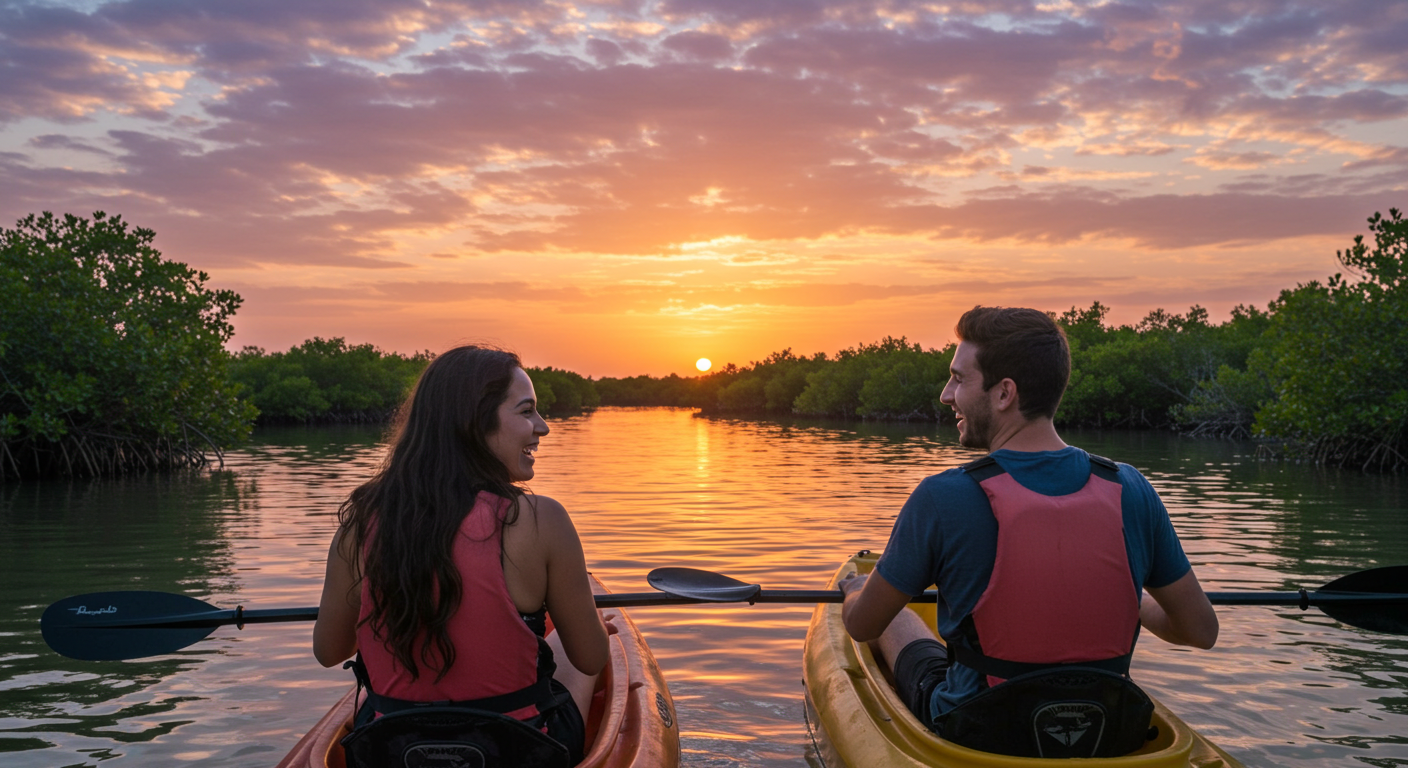
Why mangroves are important in Abu Dhabi
When people picture Abu Dhabi, they often imagine glass towers, sun-scorched dunes, and high-speed glamour. But look just beyond the city’s edge, and you’ll find something older, quieter, and far more essential: mangrove forests. These salt-loving trees don’t just survive in the UAE’s coastal zones—they thrive, offering a host of environmental, ecological, and even economic benefits.
Mangroves are not just a backdrop for kayaking adventures. They’re living infrastructure, quietly protecting the coastline and sustaining marine life while playing a surprisingly important role in climate change defense. That’s why mangroves are important in Abu Dhabi — not just for the environment, but for the future of the city itself.
What Are Mangroves, and Where Can You Find Them in Abu Dhabi?
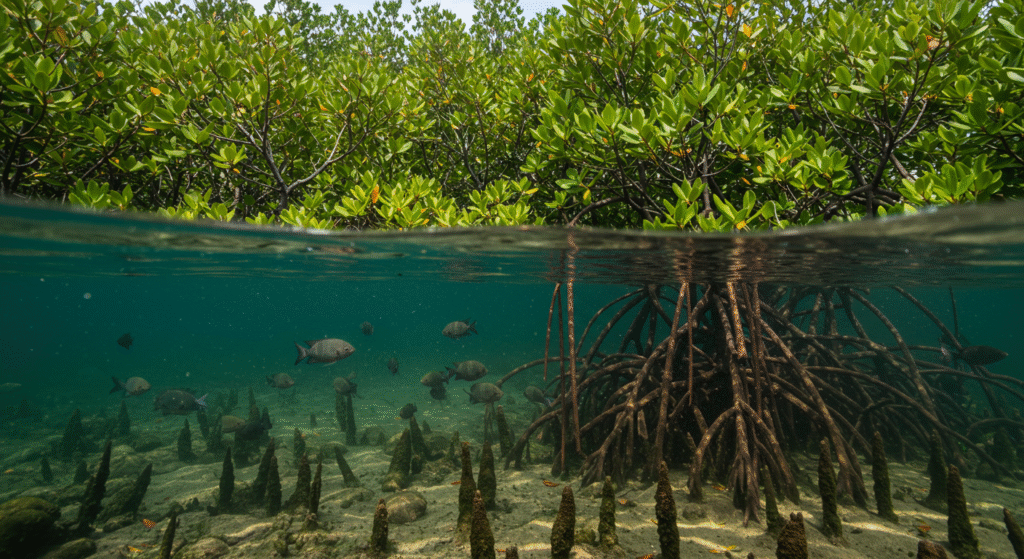
Mangroves are unique trees and shrubs that grow in saline or brackish coastal waters. Adapted to thrive in tough conditions—high salinity, muddy soil, and fluctuating tides—they form dense forests along shorelines and estuaries. Their signature aerial roots allow them to breathe in oxygen-poor soil, while their salt-filtering mechanisms help them survive what would kill most plants.
In Abu Dhabi, mangroves are found in several key locations:
-
Eastern Mangrove Lagoon National Park
-
Jubail Mangrove Park on Al Jubail Island
-
Coastal fringes of Reem Island and Yas Island
These areas are protected and carefully managed, not just for their ecological value, but also as recreational hubs. Kayaking through these mangrove forests offers residents and visitors a way to explore the UAE’s native ecosystems up close, without disturbing the delicate environment.
Mangroves as Coastal Protectors
One of the most overlooked yet essential functions of mangroves is coastal protection. With Abu Dhabi’s extensive waterfront development and island expansion, erosion and wave action have become serious concerns. Mangroves act as natural buffers, reducing the energy of waves and stabilizing the coastline.
Their intricate root systems trap sediments, helping to prevent erosion and reclaim land naturally over time. This is especially important in places like the Eastern Mangrove Lagoon, where rising sea levels and urban construction pressures meet fragile ecosystems.
In the face of stronger storm surges and unpredictable weather events—both worsened by climate change—mangroves provide a frontline defense. Unlike concrete barriers, these natural structures regenerate, adapt, and grow over time, making them a sustainable form of protection.
Biodiversity in Abu Dhabi’s Mangroves
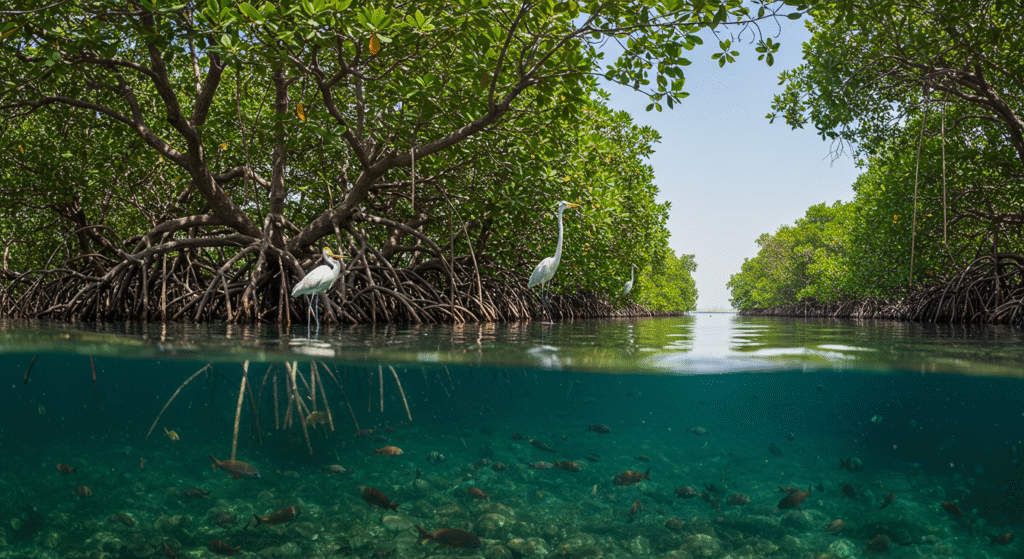
Mangroves are hotspots for biodiversity. They serve as nurseries for fish, shelter for birds, and feeding grounds for crustaceans and reptiles. In Abu Dhabi, these forests support a wide variety of wildlife, including:
-
Grey herons, egrets, and flamingos
-
Juvenile fish species that use the mangrove roots as safe habitats
-
Crabs, mudskippers, and small turtles seen frequently in shallow channels
These ecosystems also serve as migratory pitstops for birds traveling across the East African flyway. During the cooler months, you’re likely to see thousands of birds nesting, feeding, or simply pausing to rest among the branches.
For conservationists, the presence of such biodiversity in a major urban center is nothing short of remarkable. And for visitors, it’s a chance to experience nature thriving where you’d least expect it—on the edge of a modern metropolis.
Mangroves and Climate Change Defense
One of the most powerful—but least visible—roles mangroves play in Abu Dhabi is as carbon sinks. These ecosystems are capable of capturing and storing large amounts of atmospheric carbon dioxide through their roots, trunks, and the soil beneath them. In fact, mangroves absorb CO₂ more efficiently per square meter than tropical rainforests.
This makes them a key part of the UAE’s long-term environmental strategy. As the country works toward climate goals and emissions reduction, mangrove restoration has become a natural tool for carbon offsetting. The UAE has pledged to plant 100 million mangroves by 2030, a major commitment to expanding its blue carbon infrastructure.
Beyond carbon storage, mangroves also moderate temperature around coastlines and improve air quality by acting as natural filters. They offer climate resilience not just in theory, but in measurable, everyday ways—reducing flood risks, protecting coastal developments, and stabilizing microclimates in an increasingly warming world.
Education, Recreation, and Ecotourism

Mangroves aren’t just for scientists and conservationists. They’re also a growing part of Abu Dhabi’s eco-tourism landscape. Guided kayaking tours, walking boardwalks, and educational visits offer residents and tourists a chance to experience these ecosystems firsthand.
Places like Jubail Mangrove Park have become hubs for environmental learning, hosting school trips, weekend workshops, and citizen science programs. These efforts raise public awareness and help foster a culture of environmental stewardship from an early age.
Recreational activities, particularly mangrove kayak tours, allow people to explore without damaging the fragile root systems. When managed responsibly, these low-impact experiences provide both education and income to support conservation efforts.
This balance of recreation and responsibility is one reason Abu Dhabi’s mangroves are seen as a model for sustainable urban nature integration in the Gulf region.
How Mangroves Have Protected Abu Dhabi in Real Life
Mangroves are not just a theoretical solution to climate and coastal challenges—they’ve played a proven, measurable role in protecting Abu Dhabi’s shorelines and shaping its environmental policies. With their dense root systems and natural wave-dampening abilities, mangroves reduce erosion, stabilize sediment, and provide a buffer against sea-level rise.
One of the most compelling examples came in 2022, when unusually high tidal activity in the area around Eastern Mangrove Lagoon National Park was closely monitored by local environmental authorities. While nearby reclaimed coastal zones experienced minor erosion and shoreline retreat, mangrove-buffered areas remained stable. This local observation aligned with global data showing that mangroves can reduce wave energy by as much as 60–70 percent within the first 100 meters of shoreline.
In addition to passive protection, mangroves have influenced national policy and urban planning. As part of its climate and sustainability goals, Abu Dhabi launched a large-scale “Blue Carbon” project in 2019 to quantify how mangrove ecosystems contribute to carbon sequestration. This initiative led directly into the UAE’s pledge to plant 100 million mangroves by 2030, with Abu Dhabi leading many of the pilot programs.
Educational and recreational infrastructure also reinforces the importance of mangroves in city life. When Jubail Mangrove Park opened in 2020, it became more than just a boardwalk—it was designed as a public-facing model of conservation. The park offers environmental education, guided tours, and citizen-science participation, raising awareness about how mangroves contribute to both biodiversity and coastal safety.
Real-World Impacts: Mangroves in Abu Dhabi
| Initiative or Event | Year | Role of Mangroves | Impact and Outcome |
|---|---|---|---|
| Eastern Mangrove Lagoon surge observations | 2022 | Absorbed wave action and reduced shoreline erosion | Mangrove zones remained stable; adjacent reclaimed areas showed minor retreat |
| Launch of Blue Carbon monitoring program | 2019 | Tracked mangrove carbon capture and erosion control | Informed UAE’s national mangrove planting targets |
| UAE Mangrove Afforestation Pledge | 2021 | Committed to planting 100 million mangroves | Positioned mangroves as strategic tools for climate and coastal defense |
| Opening of Jubail Mangrove Park | 2020 | Public engagement, education, and ecotourism | Boosted awareness and supported long-term conservation through citizen involvement |
Threats to Mangroves in the UAE

Despite their value, mangroves in Abu Dhabi face growing pressure from:
-
Urban development and land reclamation
-
Pollution from runoff, plastics, and construction waste
-
Boat traffic, especially in unregulated areas
-
Rising sea levels and increasing water salinity due to climate change
Although protected in many zones, these forests remain vulnerable. Natural regrowth is slow, and once destroyed, mangrove ecosystems can take decades to return. That’s why restoration projects, such as satellite-monitored planting and community cleanups, are critical.
Public education and stricter coastal zoning laws have helped reduce damage in recent years. Still, ongoing vigilance is necessary to ensure that short-term growth doesn’t come at the cost of long-term ecological loss.
Why Mangroves Are Important in Abu Dhabi—and Worth Protecting
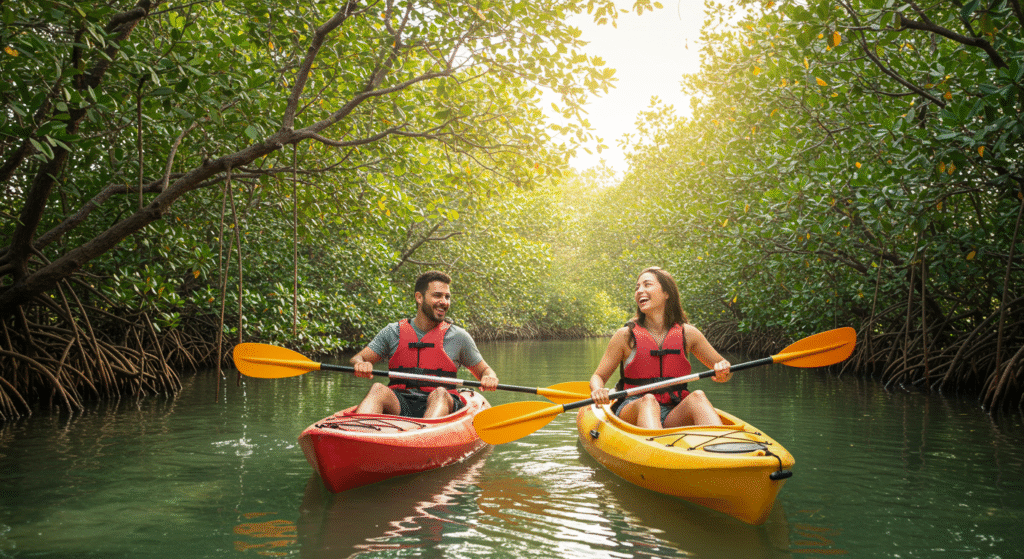
Mangroves in Abu Dhabi aren’t just trees growing in salty water. They are natural engineers, climate defenders, and biodiversity lifelines that shape both the landscape and the future of the region. From buffering coastlines to nurturing marine species and filtering the air we breathe, their contributions go far beyond the visible.
Protecting these ecosystems is not just an environmental obligation—it’s an investment in the city’s sustainability and resilience. Whether you’re a visitor paddling through mangrove channels or a resident enjoying a walk through Jubail Park, you’re engaging with one of Abu Dhabi’s most important natural assets.
Understanding their value is the first step. Helping preserve them—by exploring responsibly, supporting conservation, or even planting a mangrove of your own—is how we ensure these coastal guardians continue their quiet work for generations to come.


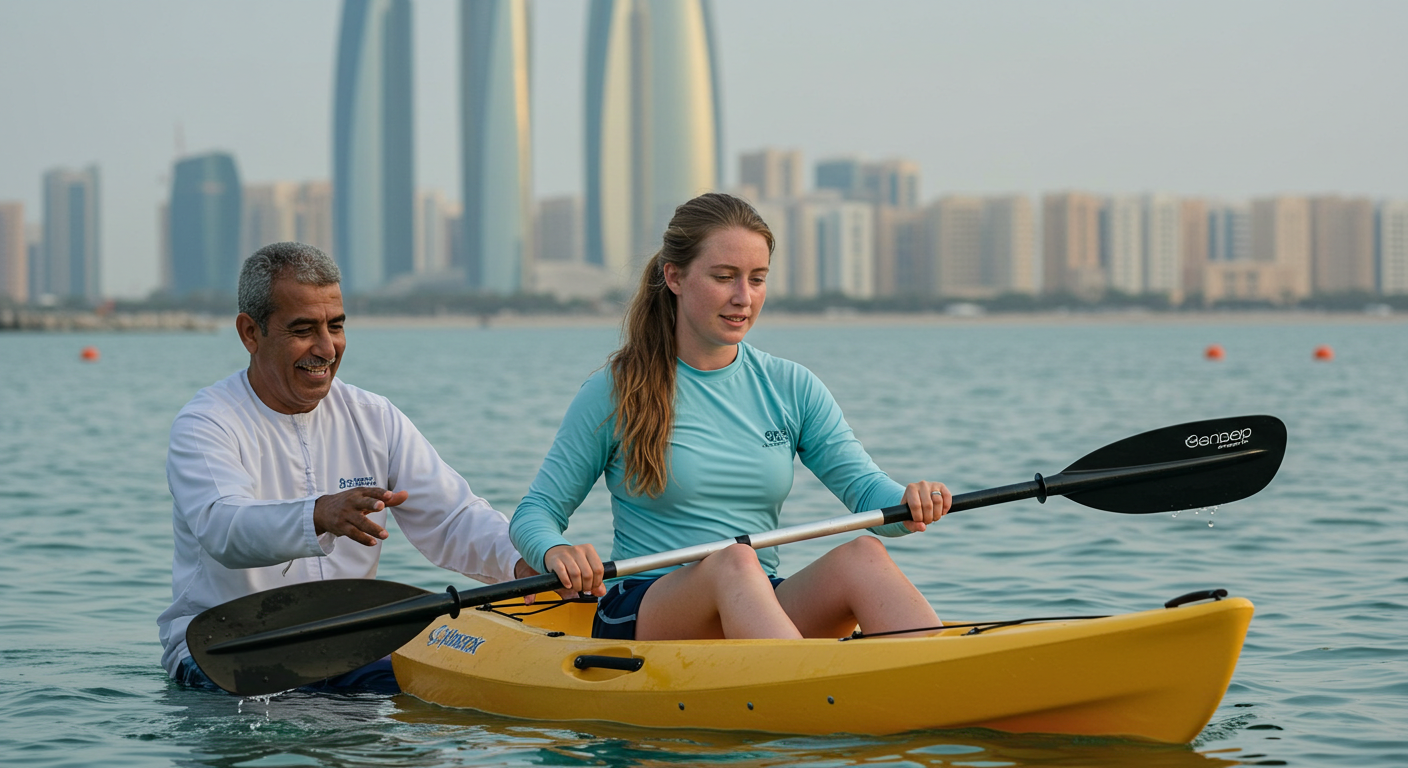
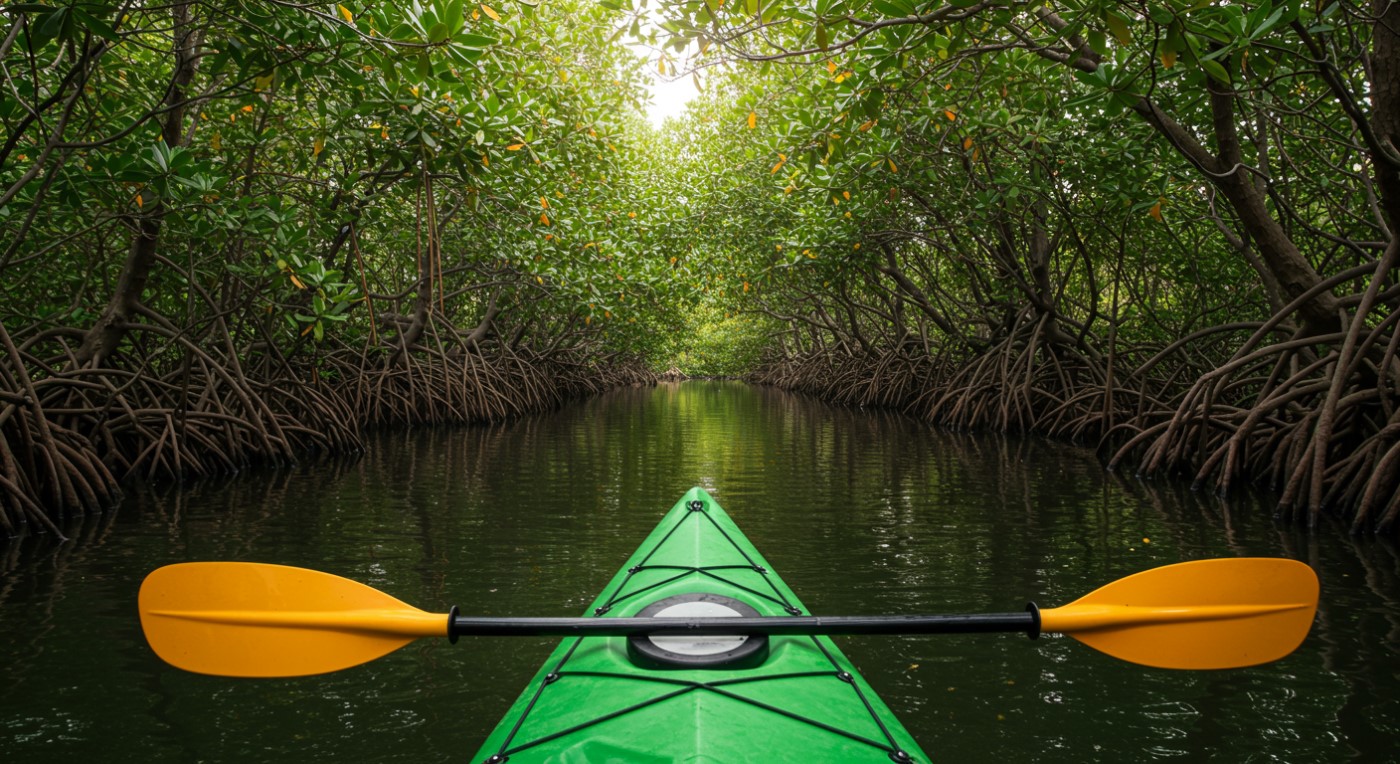
Leave a Reply